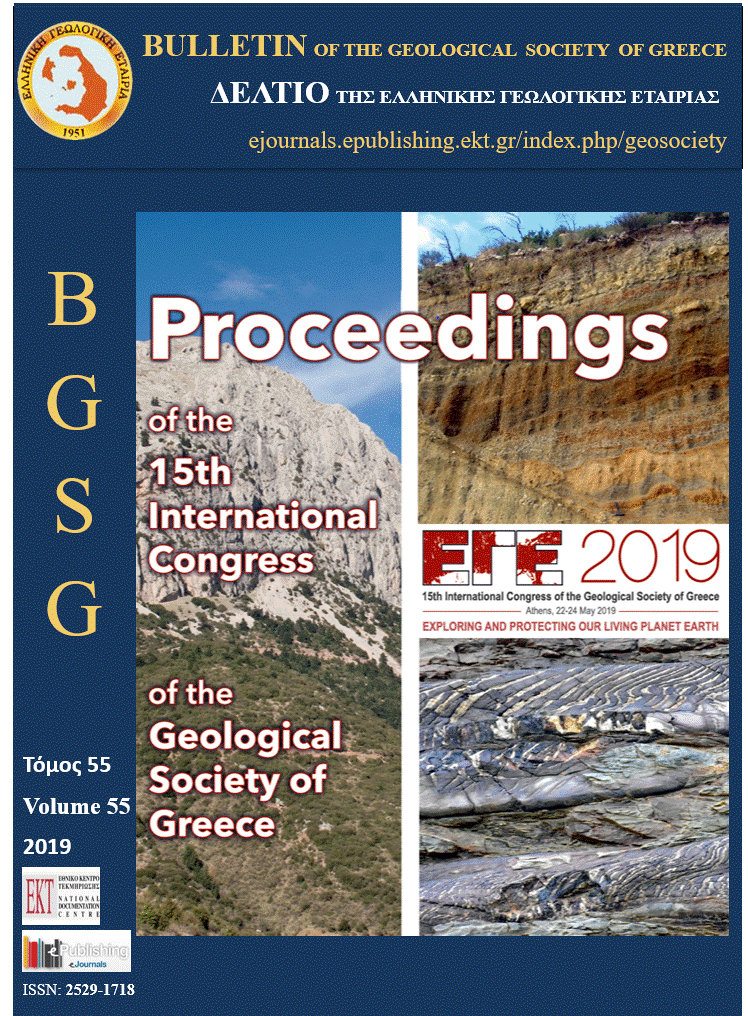Mineralogical, Petrological and Geochemical Study of the Agios Ioannis Volcanic Rocks, Kamena Vourla Area, Greece
Περίληψη
The Plio-Pleistocene volcanic center of Lichades is located in the Northern Euboean Gulf, at the western extremity of the North Anatolian Fault and it is one of the most neo-tectonically active areas in Greece. Volcanic rocks are exposed in the form of lava flows and/or domes mostly in the small islands (Lichades) offshore Kamena Vourla, as well as in a small outcrop in mainland, namely the Agios Ioannis area. Based on the results of the present study, the Agios Ioannis volcanic rocks are characterized as trachyandesites with high-K calc-alkaline affinities, similar to several volcanic rocks from the South Aegean Volcanic Arc. The petrological and mineral-chemical study reveal that the studied volcanic rocks are characterized by vitrophyric texture and a matrix dominated by glass, numerous randomly-oriented microlites of plagioclase and minor sanidine, clinopyroxene and amphibole. Phenocrysts comprise of plagioclase, olivine, quartz, clinopyroxene and amphibole. Plagioclase composition ranges from andesine to bytownite (An30-An73). Olivine cores are typically Mg-rich, and the rims display elevated FeO content. Clinopyroxenes display a narrow compositional range between augite and diopside, with the latter being more common. Amphiboles, are calcic and their composition ranges from tschermakite to tschermakitic hornblende. Mineralogical and geochemical similarities with other volcanic rocks in Greece such as Lesvos lamproites, may be helpful in understanding the genesis of the studied Agios Ioannis volcanics.
Λεπτομέρειες άρθρου
- Πώς να δημιουργήσετε Αναφορές
-
Kanellopoulos, C., Vougioukalakis, G., Mavrogonatos, C., Megremi, I., & Iliopoulos, I. (2019). Mineralogical, Petrological and Geochemical Study of the Agios Ioannis Volcanic Rocks, Kamena Vourla Area, Greece. Δελτίο της Ελληνικής Γεωλογικής Εταιρείας, 55(1), 274–289. https://doi.org/10.12681/bgsg.21128
- Ενότητα
- Πετρολογία και Ορυκτολογία

Αυτή η εργασία είναι αδειοδοτημένη υπό το CC Αναφορά Δημιουργού – Μη Εμπορική Χρήση 4.0.
Οι συγγραφείς θα πρέπει να είναι σύμφωνοι με τα παρακάτω: Οι συγγραφείς των άρθρων που δημοσιεύονται στο περιοδικό διατηρούν τα δικαιώματα πνευματικής ιδιοκτησίας επί των άρθρων τους, δίνοντας στο περιοδικό το δικαίωμα της πρώτης δημοσίευσης. Άρθρα που δημοσιεύονται στο περιοδικό διατίθενται με άδεια Creative Commons 4.0 Non Commercial και σύμφωνα με την οποία μπορούν να χρησιμοποιούνται ελεύθερα, με αναφορά στο/στη συγγραφέα και στην πρώτη δημοσίευση για μη κερδοσκοπικούς σκοπούς. Οι συγγραφείς μπορούν να: Μοιραστούν — αντιγράψουν και αναδιανέμουν το υλικό με κάθε μέσο και τρόπο, Προσαρμόσουν — αναμείξουν, τροποποιήσουν και δημιουργήσουν πάνω στο υλικό.



